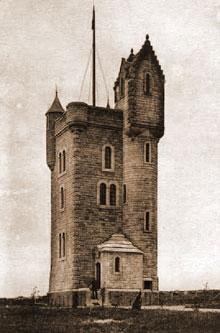Beaumont-Hamel
Thiepval

Wiltshire Regiment attack near Thiepval. Q1142: Photograph courtesy of the Imperial War Museum, London.
The village
Thiepval was one of the fortress villages that were held by the Germans on the Somme front in 1916.
The village was destroyed by the bombardment, except for one part of the chateau (the ruins of which contained machine gun nests). The houses in the village, although flattened, had deep cellars where the Germans held out, and their machine gun posts were not destroyed by the bombardment. X Corps was the attacking formation here on the 1st of July, 1916. In front of, and to the south of the village, the 32nd Division attacked. After the War ended, Thiepval was chosen as the location for the Memorial to the Missing to commemorate those who died in the Somme sector before the 20th of March 1918 and have no known grave. This is the largest and most imposing of the Memorials to the Missing, and visiting here is a moving and sobering experience.

Those who died in the Somme after 20th March 1918 are commemorated at Pozières. The 36th Division attacked just to the north of the village.
Ulster Tower
The Ulster Tower is a memorial to the men of the 36th (Ulster) Division. It is located very near to the famous Schwaben Redoubt (Feste Schwaben) which the Division attacked on July 1st, 1916. The Schwaben Redoubt was a little to the north-east of where the tower stands, and was a triangle of trenches with a frontage of 300 yards, a fearsome German strongpoint with commanding views.
The front lines were at the edge of Thiepval Wood which lies to the south-west of the road between the Thiepval memorial and the Ulster Tower. Troops of the 109th Brigade crossed about 400 yards of No Man's Land, and kept on going. They entered the Schwaben Redoubt, and advanced on towards Stuff Redoubt, gaining in all around a mile, though not without losses. To their left, the 108th Brigade were succesful in advancing near Thiepval, but less so nearer the River Ancre.
The 107th Brigade supported them, but although the men of the 36th Division held out for the day the Germans mounted counterattacks, and as their stocks of bombs and ammunition dwindled many fell back, with small parties remaining in the German front lines. The casualties suffered by the 36th Division on the 1st of July were over 5,000 in total - almost half of their strength.
The tower is a copy of Helen's Tower in County Down, where men of the 36th Division trained. The tower (plus a small cafe nearby) is staffed by members of the Somme Association which is based in Belfast, and is a friendly and welcoming place to stop on a battlefield tour.